& Shultz Brick Yard
KINGSTON, N.Y.
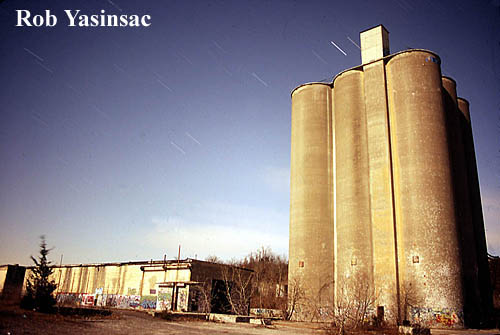
The stars of Aquila the Eagle are visible above the silos.
Hudson Cement
Company
& Shultz Brick Yard
KINGSTON, N.Y.

The stars of Aquila the Eagle are visible
above the silos.
In the
late 1950s, the Hudson Cement Company (a subsidiary of the Colonial
Sand and Stone Company) announced plans to build a cement plant on 300 acre site
with vast limestone deposits. In a previous life the property was occupied by
brick yards, including Charles Shultz' company, which formed in 1876 and
went out of business with many other brick manufacturers by World War II. The
brick yards in the "Steep Rocks" section died
out at a time when many industries in the Hudson Valley were shutting down. At
the same time however, certain industrial sites, like the cement plants, were
entering a new period of growth. One
Kingston yard, the Hutton Company Brick Works, operated through 1979 and still
survives intact today albeit abandoned.
After the wooden drying sheds of the brick yards were
dismantled, another iconic architectural form appeared along the Hudson River.
Simple, unadorned white cement silos, some 300 feet tall, appeared in Greene County near
Catskill and across the river in the city of Hudson, and also at Kingston.
Although one site at Catskill is still fully active in 2006, this industry declined
locally beginning in the 1970s as several plants closed, including the Hudson
Cement Company at East Kingston, which ceased operation in the early
1980s.
After two or three decades of utter abandonment, many Hudson River
waterfronts were eyed for transformation from industrial use to high-end
residential communities at the new millennium. At the former Hudson Cement
property, Yonkers-based AVR Realty proposed building 2,200 condominium units at
a development to be called The Landing at Kingston and Ulster. To
the south, another 300+ unit development known as Sailor's Cove threatens the Hutton Company Brick
works, one of only two intact brick yards along the Hudson River. In response, Scenic Hudson,
local citizens and New York Times editorials have questioned the rationale for
building so many units on such relatively small sites along the river, raising
the larger question of "whose riverfront is it?" - only those who can
afford the new condos or the community at large?
Until these developments are approved and built, the ruins of
the brick and cement industries survive to tell the story of life along the
Hudson in the 20th-century. At the Shultz brick yard, only the boiler flue
survives from the manufacturing operations. A mule barn also stands; it was converted
to an office for the cement company which drastically altered the interior. A
barge wreck sits in the mud off shore. The Hudson Cement Company
silos stand surrounded by garages and other smaller buildings and some rusting
machinery. The quiet reserve of the "undeveloped" waterfront made for
a pleasant evening photographing the ruins under a full moon. I doubt I'll be
back when the condos are built. Visit the
following pages (link at bottom) to see the site in daylight.
OFFSITE LINKS:
Don Bayley's BrickCollecting.com
site has a page dedicated to the Shultz Brick Company.
Town
of Ulster - Historic images of East Kingston.
Night photographs
(this page) were taken
December 2006. Yaz’ Hudson
Valley Ruins and Abandoned Buildings, etc.
Daytime photos taken January & June 2005.
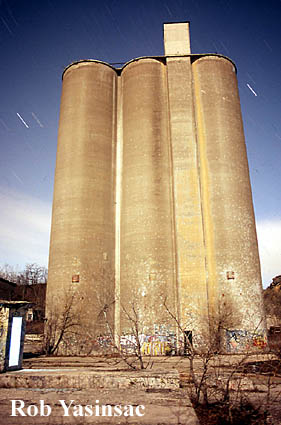
Here the silos are flanked by Aquila the Eagle (left) and Cygnus the Swan
(right).
The bright star at left is Altair, the head of the Eagle; the bright star at right is Deneb, the
tail of the Swan.
Altair marks the southerly point of the "Summer
Triangle," while Deneb is
the northwestern corner.
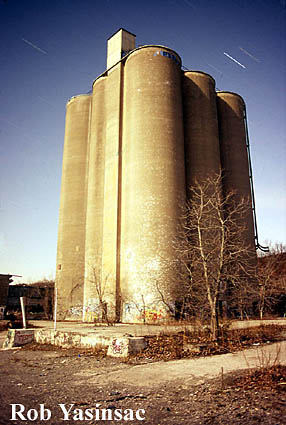
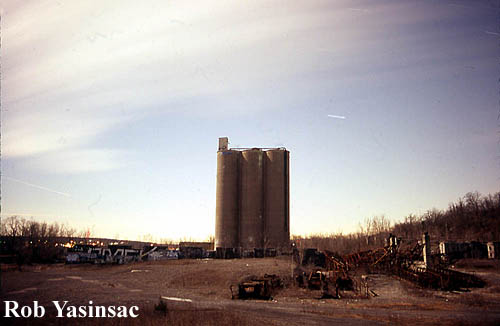
Looking south, Hudson River at left.
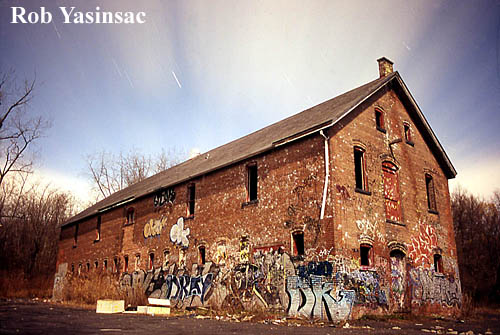
Shultz brick yard - mule barn.
Hudson
Cement Company & Shultz Brick Yard: Daytime Photos - Page 2
This page copyright © 2006
by Robert J.
Yasinsac.
Reproduction of these photos without the permission of Robert Yasinsac is prohibited.